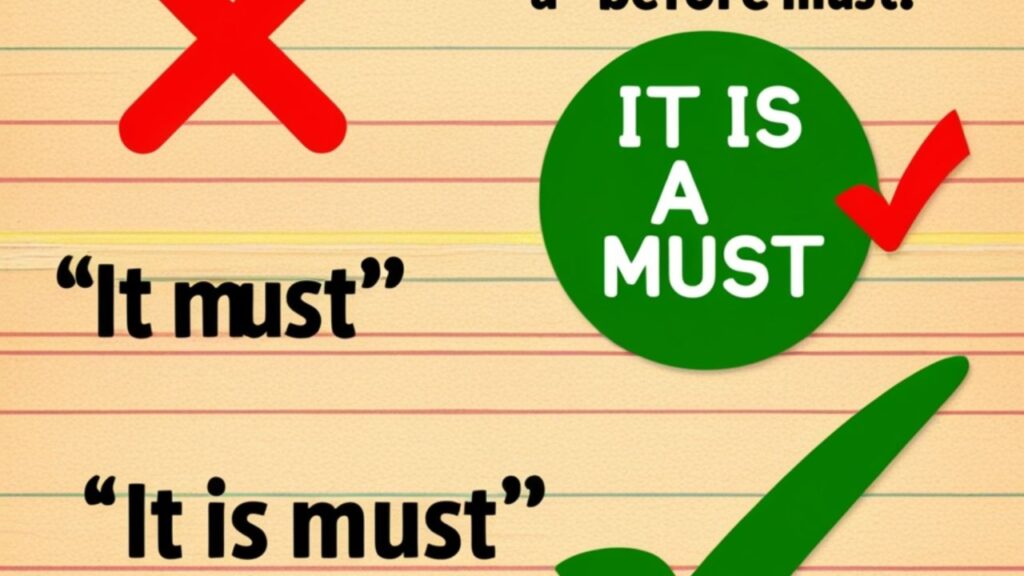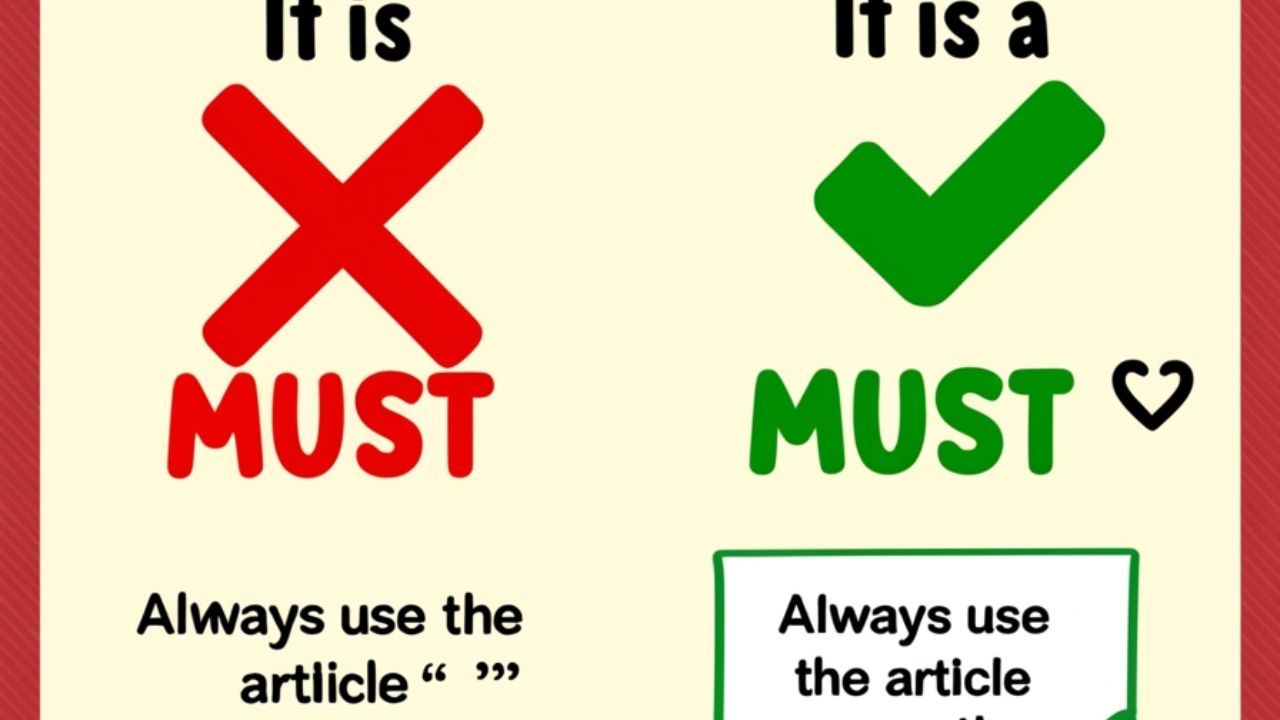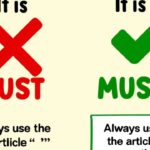It is a must means something very important or necessary. People use it to show that a thing should not be missed. For example, “Drinking water daily is a must.” It sounds correct and complete because it follows normal English grammar rules.
Some people say it is must, but that is wrong. The phrase misses the small word “a,” which makes a big difference. Without it, the sentence feels broken and unclear. The correct phrase helps your English look clean and proper.
Learning this small rule makes speaking and writing better. It helps you sound natural and smart. Always use it is a must when you want to talk about something important. This way, your English will always stay clear and right.
Hooking Introduction: Why This Phrase Causes So Much Confusion
Many people mix up it is a must and it is must when they write or speak. The mix-up happens because both sound almost the same. One small word changes the whole meaning and makes the sentence right in good English.
The word must works in two ways. It can show something you need to do or something important to have. When you learn how to use it the right way, your writing becomes clear, strong, and easy for others to understand.
Dissecting the Core: What Does “Must” Really Mean?
- The word must shows something very important or needed. It tells that an action or thing cannot be missed, like “You must eat to stay healthy.”
- Must can work as a helping word or a naming word. As a helping word, it shows duty or strong advice.
- When must acts like a naming word, it means something necessary, such as “This book is a must for reading.”
Modal Verb Examples:
- You must finish your homework before playing outside.
- She must wear a coat because it is very cold.
- They must reach school on time every morning.
See also : Minuet vs Minute: Grammar, Usage & Pronunciation Tips
Noun Examples:
- This storybook is a must for young readers.
- Wearing a helmet is a must when riding a bike.
- Drinking clean water every day is a must for good health.
The Role of ‘Must’ as a Modal Verb

As a modal verb, “must” is always followed by the base form of a verb and never stands alone.
Structure:
The structure of this phrase is very simple. It begins with “It,” then comes “is,” and finally the word “a must.” This small setup helps the sentence sound clear and complete. Every word plays an important part in making good English.
Using the right structure helps you write with confidence. When you say “It is a must,” you follow the natural pattern of English sentences. This makes your speech and writing sound correct, smooth, and easy to understand.
- The structure starts with “It,” followed by “is,” and ends with “a must.”
- Each word in the structure has a role that makes the sentence complete and correct.
- Using this structure helps your sentence sound natural and easy to understand.
Understanding ‘Must’ as a Noun: When It Refers to Necessity
The word must can act like a naming word, which means it becomes a noun. It shows something important or needed. For example, “Drinking milk is a must.” This tells that milk is necessary for health and growth.
When you use must as a noun, it works like other simple nouns. It names an idea or thing that people should have or do. This use makes sentences stronger and helps express need or importance clearly.
- The word must becomes a noun when it names something very important or needed.
- Using must as a noun shows that something is necessary, like “Sleep is a must for health.”
- This form of must helps make sentences clear, strong, and meaningful.
Real-Life Examples:
| Sentence | Function of “Must” | Grammatical Status |
| You must finish your homework. | Modal verb | Correct |
| This app is a must for designers. | Noun | Correct |
| It is must to follow the rules. | Incorrect use | Wrong |
| It is a must to follow the rules. | Noun | Correct |
The Phrase “It Is a Must”: Why It’s Grammatically Correct
- The phrase it is a must is correct because it uses the article “a” before the noun “must.”
- This form follows normal English rules and makes the sentence sound complete and proper.
- Using it is a must clearly shows that something is important or necessary.
Examples in Use:
- Wearing a seatbelt is a must when riding in a car.
- This book is a must for students who love learning new things.
- Attending the morning assembly is a must in our school.
The Phrase “It Is Must”: Why It’s Incorrect and Misleading
The error in “It is must” comes from treating a verb or unmarked noun as a stand-alone noun phrase without proper structure.
Why It Sounds Off:
- The phrase it is must sounds wrong because it misses the small word “a.”
- Without “a,” the sentence feels broken and does not follow normal grammar rules.
- Native speakers never use it is must, as it sounds unnatural and incomplete.
Examples of Incorrect Usage:
- It is must to bring your notebook every day. ❌
- That movie is must for all kids to watch. ❌
- This bag is must for school use. ❌
See also : Staccato Sentences Explained: Usage, Tips & Examples
Native Usage Insights: US vs UK English Patterns
Though both American and British English accept “It is a must,” there are some stylistic preferences.
British English:
- In British English, people often use phrases like “It is essential” instead of “It is a must.”
- The style sounds more formal and polite in British English writing.
- Many speakers in the UK prefer clearer words such as “necessary” or “important.”
American English:
- In American English, people often say “It is a must” in daily talk and writing.
- The phrase sounds friendly and natural in American English conversations.
- Americans also like using terms such as “must-have” or “can’t-miss” for strong recommendations.
Summary Table:
| Phrase Style | UK Preference | US Preference |
| It is a must | Less frequent | Very common |
| It is essential | Common in writing | Used, but less casual |
Data Deep Dive: Google Ngram Viewer Comparison

The Google Ngram Viewer shows how often words appear in books over time. It helps people see which phrases are popular. In this study, “It is a must” appeared many times, while “It is must” was seen very little.
From the Google Ngram Viewer, we learn that good grammar is used more in writing. The correct phrase became common in modern books. This proves that writers prefer clear and proper language when they want their message to sound right.
Frequency Snapshot (Books published 1950-2019):
| Phrase | Popularity Index |
| It is a must | 0.0000035 |
| It is must | 0.0000001 |
Professional Communication Matters: Why Tiny Errors Cost Big
Your language choices reflect your attention to detail. Small grammar mistakes like “It is must” may seem trivial, but they damage credibility.
In Business:
- In business, correct grammar builds trust and shows professionalism.
- Writing “It is a must” in reports or emails makes communication clear and confident.
- Small grammar errors in business writing can harm your image and reduce credibility.
In Education:
- In education, using correct grammar helps students express ideas clearly.
- Teachers expect proper phrases like “It is a must” in essays and assignments.
- Good language habits in education build confidence and improve writing and speaking skills.
Smarter Alternatives to “It Is a Must”
Want variety in your writing? Here are some alternatives:
Formal Synonyms:
- It is essential – shows that something is very important or needed.
- It is mandatory – means something must be done or followed by rules.
- It is imperative – expresses a strong need or command in a formal way.
Casual Variants:
- You gotta try it – sounds friendly and shows strong excitement or advice.
- It’s a no-brainer – means something is easy to choose or clearly worth doing.
- Don’t miss it – tells someone that something is special or worth seeing.
Rewriting Example:
| Original | Alternative |
| It is a must | It’s highly recommended |
| That is a must-read | It’s essential reading |
Synonyms & Contextual Phrasing: Sounding Fluent and Natural
| Use Case | Preferred Phrase |
| Job Interview Advice | It is imperative |
| Casual Blog Post | It’s a must-see |
| Academic Paper | It is essential |
| Product Review | A must-have |
Side-by-Side Usage Comparison: Right vs. Wrong
| Incorrect Phrase | Correct Version | Explanation |
| It is must | It is a must | Needs article “a” |
| This is must | This is a must | “Must” used as noun |
| Is must be done | It must be done | Modal verb needs structure |
| Must-have item it is | It is a must-have item | Sentence needs reordering |
Case Studies: How Writers and Speakers Get This Wrong
Example 1: Social Media
Incorrect: “This product is must!” Correct: “This product is a must!”
Example 2: Online Review
Incorrect: “It is must to have insurance.” Correct: “It is a must to have insurance.”
Example 3: Email from a Candidate
Incorrect: “Working with your company is must for my career.” Correct: “Working with your company is a must for my career.”
Grammar Tip Sheet: Avoiding These Common Slip-Ups
- Always add “a” before must when it works as a noun in a sentence.
- Never use must alone without context; pair it with a verb or article.
- Read sentences aloud to check if they sound clear and natural in English.
Mnemonic:
If it’s a thing, it needs a ring (an article).
The Power of Precision: Why It Matters in 2025 and Beyond
The power of precision helps people write and speak clearly. In 2025, good language skills make a big difference in school and work. Using the right words shows care, respect, and understanding, which builds trust with teachers, friends, and others.
In the future, the power of precision will help everyone share ideas better. Clear writing supports learning and smart communication. When people use the correct words, they show confidence and kindness, making their thoughts easy for everyone to follow and enjoy.
Conclusion
In conclusion, learning simple grammar rules helps you speak and write better. Small changes, like using “a” in the right place, make sentences sound proper. Clear language builds confidence and shows that you understand how English works.
This conclusion reminds us that correct words create strong meaning. When you use proper grammar, people understand you easily. Good communication starts with careful learning and practice, helping every student share thoughts in a kind and correct way.
FAQs
What is the meaning of it is a must?
It means something is essential, necessary, or highly recommended to do or have.
Is it correct to say it is a must?
Yes, it’s correct and commonly used to emphasize importance or necessity.
When to use a must?
Use “a must” when describing something vital, such as “This book is a must for learners.”
How do you say something is a must?
You can say “It’s essential,” “It’s required,” or “It’s highly recommended” as alternatives.

Join Bibcia on a journey to master English grammar. Discover easy lessons, writing tips, and practical examples designed to make learning grammar simple and effective.










